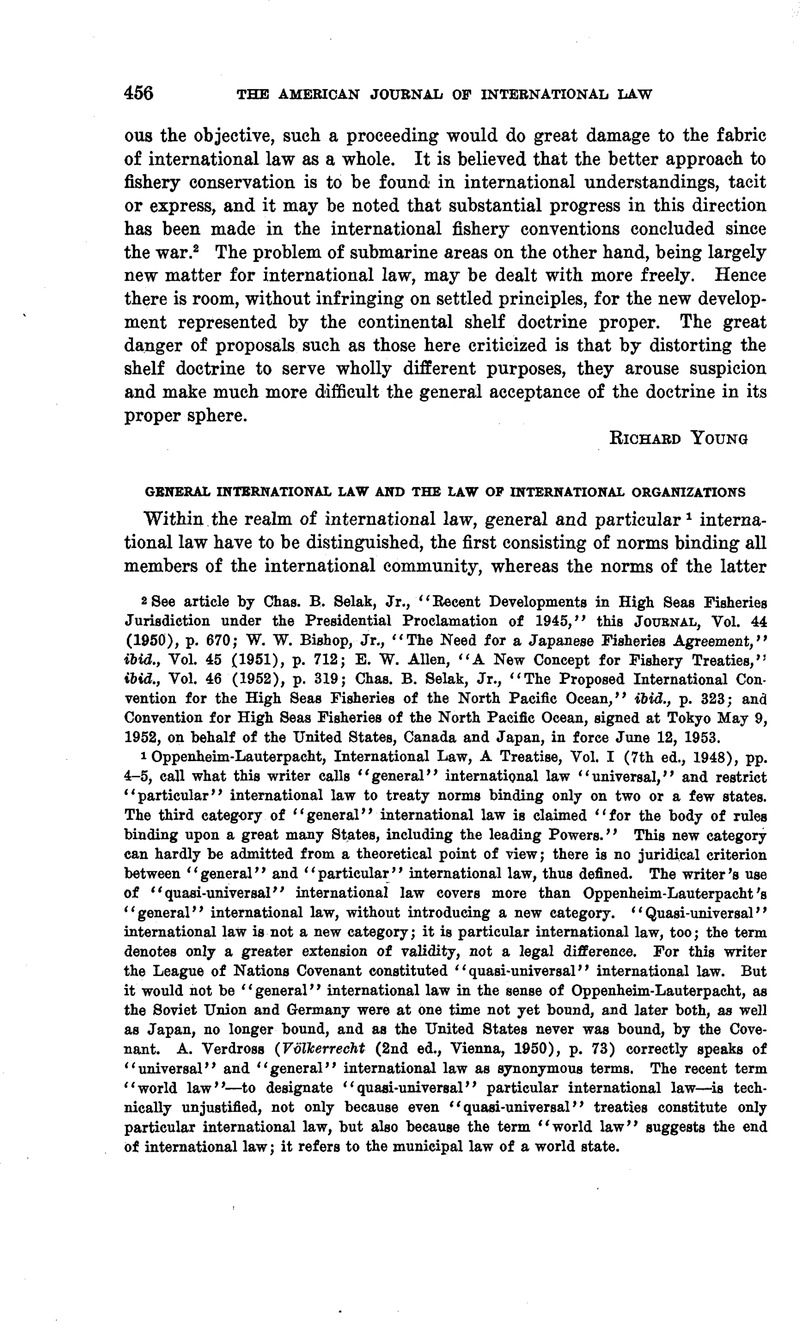Article contents
General International Law and the Law of International Organizations
Published online by Cambridge University Press: 20 April 2017
Abstract

- Type
- Editorial Comment
- Information
- Copyright
- Copyright © American Society of International Law 1953
References
1 Oppenheim-Lauterpacht, International Law, A Treatise, Vol. I (7th ed., 1948), pp. 4–5, call what this writer calls “general” international law “universal,” and restrict “particular” international law to treaty norms binding only on two or a few states. The third category of “general” international law is claimed “for the body of rules binding upon a great many States, including the leading Powers.” This new category can hardly be admitted from a theoretical point of view; there is no juridical criterion between “general” and “particular” international law, thus defined. The writer’s use of “quasi-universal” international law covers more than Oppenheim-Lauterpacht’s “general” international law, without introducing a new category. “Quasi-universal” international law is not a new category; it is particular international law, too; the term denotes only a greater extension of validity, not a legal difference. For this writer the League of Nations Covenant constituted “quasi-universal” international law. But it would not be “general” international law in the sense of Oppenheim-Lauterpacht, as the Soviet Union and Germany were at one time not yet bound, and later both, as well as Japan, no longer bound, and as the United States never was bound, by the Covenant. A. Verdross (Völkcerrecht (2nd ed., Vienna, 1950), p. 73) correctly speaks of “universal” and “general” international law as synonymous terms. The recent term “world law”—to designate “quasi-universal” particular international law—is technically unjustified, not only because even “quasi-universal” treaties constitute only particular international law, but also because the term “world law” suggests the end of international law; it refers to the municipal law of a world state.
2 P. Guggenheim (Lehrbuch des Völkerrechts, Vol. I, p. 48), calls, following Max Huber, “droit international commun” the norms valid in the whole spatial sphere of international law, but is of opinion that to them also belong norms not created by custom.
3 It is, therefore, easy to agree with Percy E. Corbett’s sentence (Law and Society in the Relations of States (New York, 1951), p. 12) “that the future of international law is one with the future of international organization,” because it means only that the future of international law lies in the progress to a more advanced international law.
4 P.C.I.J., Series B, Nos. 2/3 (Competence of International Labor Organization).
5 P.C.I.J., Series B, No. 5, pp. 27-28.
6 The Law of the United Nations (London, 1950), pp. 106–110.
7 That is why Kelsen in his new work, Principles of International Law (New York, 1952), which deals with general international law, includes a detailed analysis of fundamental principles of the U.N. Charter (p. VII). This interpretation is also accepted by Alf Boss, Constitution of the United Nations (New York, 1950), pp. 32–33.
8 See Josef L. Kunz, “Revolutionary Creation of Norms of International Law,” this Journal, Vol. 41 (1947), pp. 119–126; Goodrich and Hambro, Charter of the United Nations (2nd ed., Boston, 1949), pp. 108–110; Oppenheim-Lauterpacht, op cit, p. 371: “Without imposing legal obligations upon non-member States”; N. Bentwich and A. Martin, A Commentary on the Charter of the United Nations (New York, 1950), p. 14: “The Charter does not purport to impose legal obligations on non-members. … (They) will have to obey not as a matter of law, but as the result of the realities of power”; P. Guggenheim, op. cit., Vol. I, p. 92.
9 Kelsen, op. cit. (note 7, supra), p. VIII.
10 I.C.J. Reports, 1948, p. 61.
11 G. Niemeyer, “The Balance Sheet of the League Experiment,” International Organization, Vol. VI, No. 4 (November, 1952), pp. 537–558, at p. 542.
12 Sir Gladwyn Jebb, “The Role of the United Nations,” ibid., pp. 509–520.
13 League of Nations—U.N.; International Institute of Agriculture—FAO; International Institute of Intellectual Cooperation—UNESCO.
14 Josef L. Kunz, “Experience and Technique in International Administration,” Iowa Law Eeview, Vol. 31, No. 1 (November, 1945), pp. 40–57.
15 See Wilfred Jenks, “Coordination: A New Problem of International Organization,” Hague Academy of International Law, Recueil des Cours, 1950, II, pp. 157–302, and in British Yearbook of International Law, Vol. 28, 1951 (London, 1952), pp. 29–89.
16 Article 55.
17 See Charles H. Alexandrowicz, International Economic Organizations (London, 1952).
18 Proceedings, XXV/2, January, 1953.
19 Boudreau on WHO and FAO (ibid., pp. 134–143); Basch on financing economic developments (ibid., pp. 157–170); Klineberg on UNESCO (ibid., pp. 187–197).
20 Ibid., pp. 145–155.
21 “Considerazioni su alcuni sviluppi dell’organizzasione internazionale,” La Comunitá Internazionale (Rome), Vol. VII, No. 4, pp. 527–567.
- 4
- Cited by


